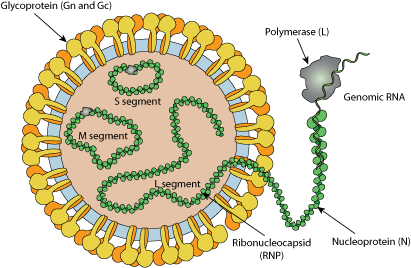VIRION

Enveloped, spherical. Diameter from 80 to 120nm.
GENOME
Segmented Negative-stranded RNA linear genome, L segment is about 8.8kb, M segment about 4.8kb and S segment about 3kb.
Encodes for six proteins.
GENE EXPRESSION
Transcription starts by viral RNA dependent RNA polymerase (L) binding to a promoter on each encapsidated segment, and is terminated by a strong hairpin sequence at the end of each gene. mRNAs are capped by L protein during synthesis using cap snatching , but are not polyadenylated.
S and M segments uses ambisense strategy to encode forsevral proteins: both genomic ans antigenomic RNA are transcribed. The hairpin sequence is a stop polymerase signal which prevents ambisense transcription from producing dsRNA. MRNA1 encodes for a polyprotein which is cleaved by host protease into Gn and Gc proteins.
ENZYMES
REPLICATION
IN PLANT:CYTOPLASMIC
- Virus penetrates into the cell by effraction or plasmodesmata transport.
- Cytoplasmic transcription by viral polymerase on the RNA viral RNA template.
- Replication presumably starts when enough nucleoprotein is present to encapsidate neo-synthetized antigenomes and genomes.
- The ribonucleocapsid can penetrate in neighboring plant cells through plasmodesmata transport
- Alternatively budding of particles occurs at the cell membrane, releasing new virions.
IN INSECT:CYTOPLASMIC
- Attachment of the viral G glycoproteins to host receptors.
- Fusion of virus membrane with the vesicle membrane; ribonucleocapsid is released into the cytoplasm.
- Cytoplasmic transcription by viral polymerase on the RNA viral RNA template.
- Replication presumably starts when enough nucleoprotein is present to encapsidate neo-synthetized antigenomes and genomes.
- Budding of particles occurs at the cell membrane, releasing new virions.


